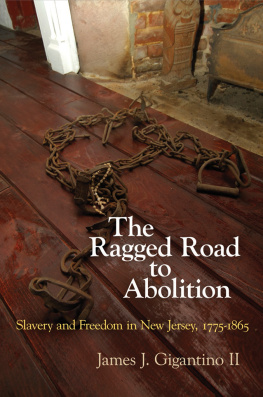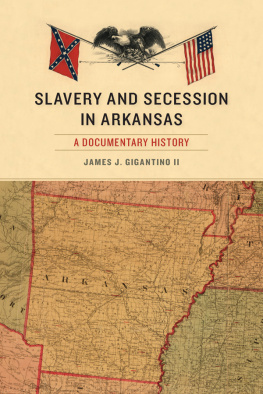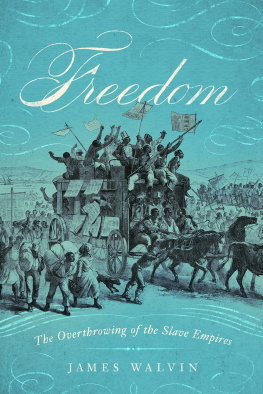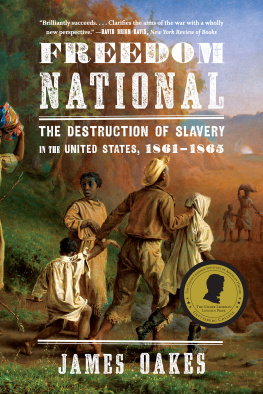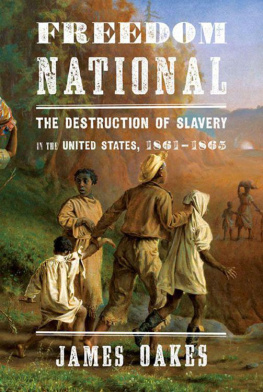The Ragged Road to Abolition
The RAGGED ROAD TO ABOLITION

Slavery and Freedom in New Jersey, 17751865
JAMES J. GIGANTINO II

university of pennsylvania press
philadelphia
Copyright 2015 University of Pennsylvania Press
All rights reserved.
Except for brief quotations used for purposes of review or scholarly citation, none of this book may be reproduced in any form by any means without written permission from the publisher.
Published by
University of Pennsylvania Press
Philadelphia, Pennsylvania 19104-4112
www.upenn.edu/pennpress
Printed in the United States of America on acid-free paper
1 3 5 7 9 10 8 6 4 2
Library of Congress Cataloging-in-Publication Data
Gigantino, James J., II, 1983
The ragged road to abolition : slavery and freedom in New Jersey, 17751865 / James J. Gigantino II. 1st ed.
p. cm.
Includes bibliographical references and index.
ISBN 978-0-8122-4649-0 (hardcover : alk. paper)
1. SlaveryNew JerseyHistory. 2. SlaveryNew JerseyLegal status of slaves in free statesHistory. 3. Anti-slavery movementsNew Jersey History. 4. New JerseyHistory17751865. I. Title.
E445.N54G54 2014
306.3620974903dc23
2014012275
To my parents, Lois and Jim Gigantino, who have helped make me the man I am today
CONTENTS


State of New Jersey, county lines 17531824.
Based on map created by R. Ryan Lash with information from Minnesota Population Center, National Historical Geographic Information: Pre-release Version 0.1, 2004.
Introduction
This book is about the meaning of slavery and freedom in the United States. The setting, though unconventional, is central to American understandings of these two loaded terms. It follows the story of abolition in the North but reverses the usual narrative: slavery did not die after the Revolution, it sustained itself until the Civil War.
In 1789, Catherine was born a slave in Hunterdon County, New Jersey. Like thousands of other slaves in the state, she worked daily for her master, John Hagaman, on his hundred-acre farm in Amwell. Cate, as her master called her, forged relationships with other slaves and in 1811 at twenty-two bore her first child, a boy named Bob, though the boys father remains unknown. Four years later, Catherine welcomed a daughter named Hannah. In 1840, Catherine moved with her master to neighboring Raritan without her children. Although the 1850 Census recorded her as a free woman, on February 16, 1856, Hagaman sold sixty-seven-year-old Catherine as a slave for life for twenty dollars to Charles Sutphin of Sommerville. After the sale, Hagaman, himself not much older than Catherine, moved with his son Dennis and daughter-in-law Mary to Joshua, Illinois, forty miles west of Peoria.
Northern slaves like Catherine have usually been portrayed as peripheral to the overall development of the North and of the United States even though she experienced slavery decades after abolitions enactment and in the midst of national debates over abolition and slaverys westward expansion. Slavery in the North never attained the same position in the economy as it did in the Caribbean, the Chesapeake, or the Low Country since the North remained a society with slaves rather than a slave society. Indeed, early travel accounts describe New Jersey as both a place of few slaves and abundant opportunity. One visitor, Francisco de Miranda, the Spanish general, American ally, and future liberator of Venezuela, remarked during a 17831784 stay that he had not encountered an individual who was ill clothed, hungry, sick, or idle. Out of all the places he visited in America, de Miranda had never seen any other place in which the people appear happier and on more of an equality than New Jersey. According to him, New Jersey was truly the Garden of America.
Just six years after de Mirandas visit, roughly 11,500 slaves lived in New Jersey. The Garden of America had more enslaved blacks than all of New England combined and almost the same slave to total population ratio as the much larger New York. Of course, the slave populations in most of the South easily outpaced New Jersey, though from 1790 to 1830 the state had more than twice as many slaves as Delaware. Additionally, some Jersey counties de Miranda likely visited heavily depended on slave labor. Bergen, for example, counted over 18 percent of its population as slaves at the time. Slaves likewise made up almost 15 percent of Somersets population, while Middlesex and Monmouth had a slave population of just under 10 percent.
While less than 1 percent of New Englands population remained enslaved by 1790, about 6 percent of the population in New York and New Jersey were slaves. Historians have glossed over these differences to argue that, while abolition came later in these two states (1799 and 1804 respectively) because of the larger slave population, the end result was the same: abolition produced a free black North that contrasted sharply with an enslaved South. The idea that abolition crept inevitably across the North after the Revolution leaves out most of the story and indeed many of its best chapters. As one historian put it, slavery died hard in the North, but the way it died illuminates far more than the fact that it died at all.
In this book I examine the long life of slavery in New Jersey and how whites and blacks adapted to the changes abolition brought. I see New Jersey and its gradual move toward abolition as part of a much wider web of interconnected relationships that crossed state and national borders as well as the Atlantic Ocean. By the end of the eighteenth century, freedom and slavery had been discussed from Boston to Barbados in the context of the Enlightenment and the American Revolution. New Jersey was part of this conversation by virtue of the trade, politics, and war conducted from its own ports, Burlington and Perth Amboy, and the nearby commercial hubs of New York and Philadelphia. New Jerseyans had a front row seat for imperial discussions over taxation, war, and abolition as the Delaware and Hudson Rivers became vehicles for the exchange of information, goods, culture, ideas, and people.
New Jersey, therefore, is one of the best laboratories in which to test the meaning and influence of abolition in the United States because its prime location exposed it to issues and ideas of freedom from around the globe. The state was significant during the American Revolution, as British and Patriot armies engaged in more battles within its borders than in any other state, and its revolutionary experience made the call for liberty and freedom integral to the states birth. Yet for all the patriotic fervor of the revolutionary generation, New Jersey delayed enactment of gradual abolition until 1804, later than any other northern state. This book explores why that delay occurred and how Jersey slaves experienced, or frequently did not experience, freedom after 1804.
In the last twenty-five years, the memory of northern slavery has been revived as many northern states have created Amistad Commissions and mandated that the local history of slavery be taught in their classrooms. The 1991 discovery of the African Burial Ground in New York City likewise spurred debate over slaverys presence in the North.
Next page
